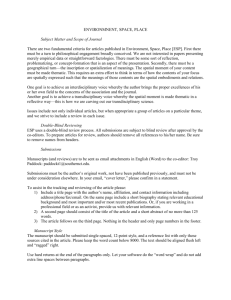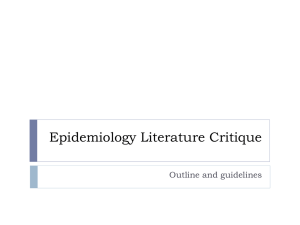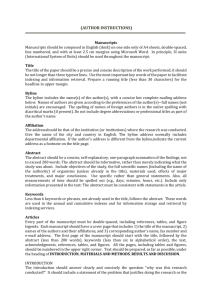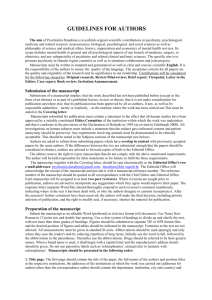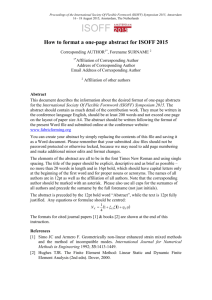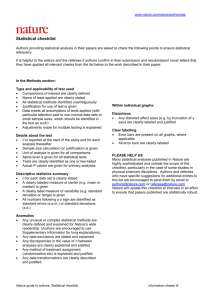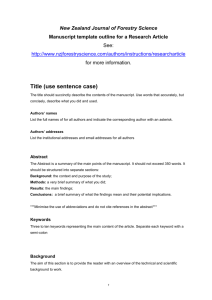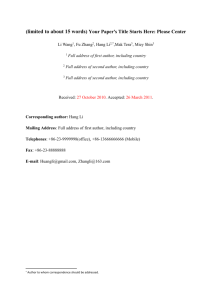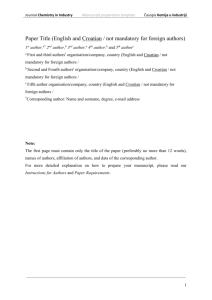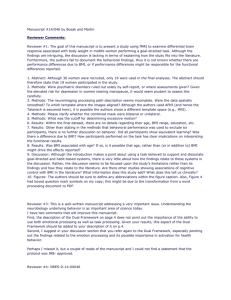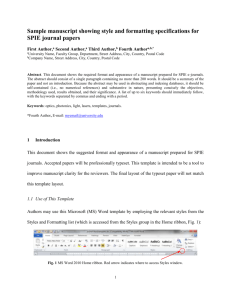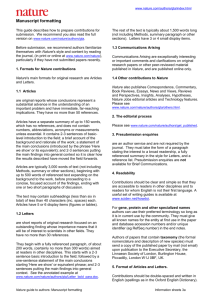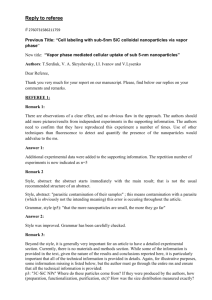Style Sheet
advertisement
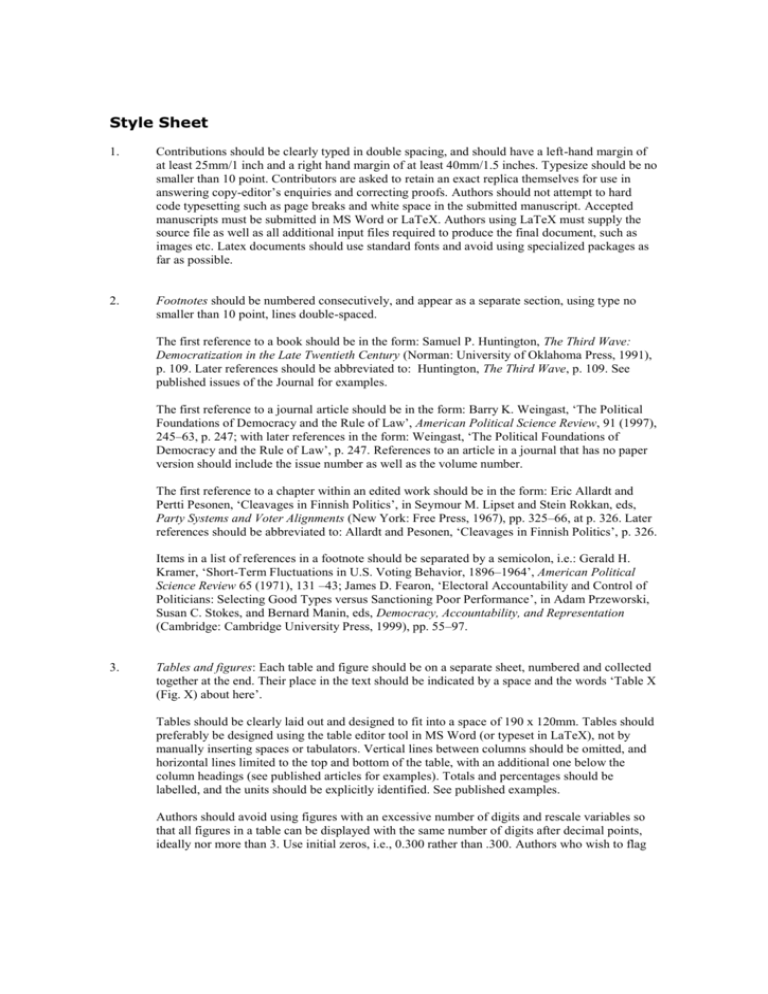
Style Sheet 1. Contributions should be clearly typed in double spacing, and should have a left-hand margin of at least 25mm/1 inch and a right hand margin of at least 40mm/1.5 inches. Typesize should be no smaller than 10 point. Contributors are asked to retain an exact replica themselves for use in answering copy-editor’s enquiries and correcting proofs. Authors should not attempt to hard code typesetting such as page breaks and white space in the submitted manuscript. Accepted manuscripts must be submitted in MS Word or LaTeX. Authors using LaTeX must supply the source file as well as all additional input files required to produce the final document, such as images etc. Latex documents should use standard fonts and avoid using specialized packages as far as possible. 2. Footnotes should be numbered consecutively, and appear as a separate section, using type no smaller than 10 point, lines double-spaced. The first reference to a book should be in the form: Samuel P. Huntington, The Third Wave: Democratization in the Late Twentieth Century (Norman: University of Oklahoma Press, 1991), p. 109. Later references should be abbreviated to: Huntington, The Third Wave, p. 109. See published issues of the Journal for examples. The first reference to a journal article should be in the form: Barry K. Weingast, ‘The Political Foundations of Democracy and the Rule of Law’, American Political Science Review, 91 (1997), 245–63, p. 247; with later references in the form: Weingast, ‘The Political Foundations of Democracy and the Rule of Law’, p. 247. References to an article in a journal that has no paper version should include the issue number as well as the volume number. The first reference to a chapter within an edited work should be in the form: Eric Allardt and Pertti Pesonen, ‘Cleavages in Finnish Politics’, in Seymour M. Lipset and Stein Rokkan, eds, Party Systems and Voter Alignments (New York: Free Press, 1967), pp. 325–66, at p. 326. Later references should be abbreviated to: Allardt and Pesonen, ‘Cleavages in Finnish Politics’, p. 326. Items in a list of references in a footnote should be separated by a semicolon, i.e.: Gerald H. Kramer, ‘Short-Term Fluctuations in U.S. Voting Behavior, 1896–1964’, American Political Science Review 65 (1971), 131 –43; James D. Fearon, ‘Electoral Accountability and Control of Politicians: Selecting Good Types versus Sanctioning Poor Performance’, in Adam Przeworski, Susan C. Stokes, and Bernard Manin, eds, Democracy, Accountability, and Representation (Cambridge: Cambridge University Press, 1999), pp. 55–97. 3. Tables and figures: Each table and figure should be on a separate sheet, numbered and collected together at the end. Their place in the text should be indicated by a space and the words ‘Table X (Fig. X) about here’. Tables should be clearly laid out and designed to fit into a space of 190 x 120mm. Tables should preferably be designed using the table editor tool in MS Word (or typeset in LaTeX), not by manually inserting spaces or tabulators. Vertical lines between columns should be omitted, and horizontal lines limited to the top and bottom of the table, with an additional one below the column headings (see published articles for examples). Totals and percentages should be labelled, and the units should be explicitly identified. See published examples. Authors should avoid using figures with an excessive number of digits and rescale variables so that all figures in a table can be displayed with the same number of digits after decimal points, ideally nor more than 3. Use initial zeros, i.e., 0.300 rather than .300. Authors who wish to flag ‘statistically significant’ statistics using asterisks should avoid using excessive numbers of asterisks and consider alternative symbols such as a dagger if they wish to indicate a large number of significance levels. Figures should not contain more detail than can be clearly shown in a space of 200 x 133mm and should be computer drawn. The resolution of images should be at least 300 dpi. Authors should avoid figures using shaded outer margins and figures using colours other than greyscale. Although it is possible to publish figures in colour where this is required, this must be agreed in advance and the authors may have to cover the additional costs of colour printing. Authors should ensure that they have permission to reproduce any copyrighted material. 4. The British Journal of Political Science has a replication policy. Authors of papers published in the journal using quantitative data are required to address the issue of replication data availability in the first footnote of their manuscript, along with any supplementary on-line appendices and acknowledgments of research support/assistance. Authors are expected to submit the information necessary to reproduce their numerical results with the final submission of their article, or indicate when this material will be available or why it cannot be made available. Authors are also encouraged to include syntax files or other information in addition to the data that may be helpful to reproduce the results in the manuscript. A statement explaining why the data or other material used in the manuscript cannot be shared, or justifying their embargo for a limited period beyond publication may fulfil this requirement. However, BJPolS strongly encourages authors to comply with the spirit of the replication policy and embrace the professional norms of accountability and openness. A typical footnote might read: 'Support for this research was provided by the Economic and Social Research Council (grant ***). An online appendix with supplementary tables and mathematical proofs and replication data are available at http://journals.cambridge.org/action/displayJournal?jid=JPS.' 5. Quotations of more than 50 words should be indented in the typescript and typed in double line spacing. Use single inverted commas for shorter quotations. Square brackets should be used to enclose interpolations, and three dots to indicate omissions. Make sure there are no errors in the spelling, punctuation and capitalization of quotations. 6. Spelling: English spelling, not American. In general use the spelling –ize (not –ise), connection, judgement, dispatch, co-operation, biased, focused. Capitals: Use as few as possible and use them consistently. Italics should be used for foreign words other than proper names. Italics for emphasis are discouraged. Abbreviations: Omit full stops in abbreviations consisting of capital letters (MP, USA). Use capitals for acronyms such as NATO and UNESCO. Dates should be in the form 1 May 1968, 1970s (no apostrophe), the twentieth century. Numbers up to 100 should normally be spelt out, except for percentages, exact quantities, or a series of numbers. Use ‘per cent’ (not %) except in tables. Include a comma in numbers over 999. The second of a pair of numbers should be abbreviated (i.e. 175–6 not 175–176), except for numbers 11–19 which retain the 1. 7. We expect authors to use gender-neutral language. 8. Proofs are supplied only to ensure that the printed version coincides with the manuscript accepted. Rewriting an article in proof is not possible. You will be sent a copy-edited version as an attachment, along with any questions that have arisen, before the article goes to the printer. Please make sure that your manuscript is in a final form at this stage.


